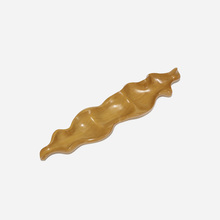

I had the opportunity to recently visit one of the most breathtaking homes, studio and private gardens located about an hour from New York City by car.
On the eastern side of the Bear Mountain Bridge, where struggling backpackers on the Appalachian Trail emerge from the woods to cross the Hudson River, is nestled one of the least-known modernist monuments of landscape architecture. Manitoga (“Place of Great Spirit” in Algonquin) is the quirky, holistic minor masterpiece of Russel Wright (1904-1976), one of this century’s most influential ceramic, glass and furniture designers.Listed on the National Register of Historic Places, Manitoga is a “garden of woodland paths” (Wright’s description) and is open to the public. Russel and Mary Wright acquired it in 1941 as an 80-acre weekend retreat, and it slowly evolved into their permanent home. After Mary’s death in 1952, the increasingly reclusive designer began work on the site’s central dwelling, Dragon Rock, which he completed in 1961.
Inviting comparisons at first glance with Frank Lloyd Wright’s Fallingwater, Dragon Rock surrenders completely to its surroundings, a cliff-side grotto on 11 levels. As a laboratory for Wright’s late 1950s concern with domestic order and environmentalism, Dragon Rock should not be missed when touring the Hudson Valley.
As I have previously posted, Russel Wright’s industrial design is personally interesting to me and was my first collectable.





